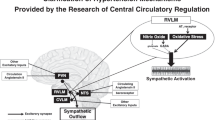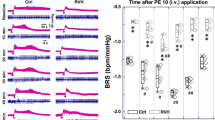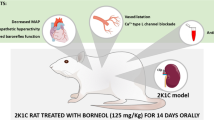Abstract
Intracerebroventricular (icv) injection of hydrogen peroxide (H2O2) or the increase of endogenous H2O2 centrally produced by catalase inhibition with 3-amino-1,2,4-triazole (ATZ) injected icv reduces the pressor responses to central angiotensin II (ANG II) in normotensive rats. In the present study, we investigated the changes in the arterial pressure and in the pressor responses to ANG II icv in spontaneously hypertensive rats (SHRs) and 2-kidney, 1-clip (2K1C) hypertensive rats treated with H2O2 injected icv or ATZ injected icv or intravenously (iv). Adult male SHRs or Holtzman rats (n = 5–10/group) with stainless steel cannulas implanted in the lateral ventricle were used. In freely moving rats, H2O2 (5 μmol/1 μl) or ATZ (5 nmol/1 μl) icv reduced the pressor responses to ANG II (50 ng/1 µl) icv in SHRs (11 ± 3 and 17 ± 4 mmHg, respectively, vs. 35 ± 6 mmHg) and 2K1C hypertensive rats (3 ± 1 and 16 ± 3 mmHg, respectively, vs. 26 ± 2 mmHg). ATZ (3.6 mmol/kg of body weight) iv alone or combined with H2O2 icv also reduced icv ANG II-induced pressor response in SHRs and 2K1C hypertensive rats. Baseline arterial pressure was also reduced (−10 to −15 mmHg) in 2K1C hypertensive rats treated with H2O2 icv and ATZ iv alone or combined and in SHRs treated with H2O2 icv alone or combined with ATZ iv. The results suggest that exogenous or endogenous H2O2 acting centrally produces anti-hypertensive effects impairing central pressor mechanisms activated by ANG II in SHRs or 2K1C hypertensive rats.
This is a preview of subscription content, access via your institution
Access options
Subscribe to this journal
Receive 12 print issues and online access
$259.00 per year
only $21.58 per issue
Buy this article
- Purchase on Springer Link
- Instant access to full article PDF
Prices may be subject to local taxes which are calculated during checkout







Similar content being viewed by others
References
Rahimi K, Emdin CA, MacMahon S. The epidemiology of blood pressure and its worldwide management. Circ Res. 2015;116:925–36.
Doris PA. Genetics of hypertension: an assessment of progress in the spontaneously hypertensive rat. Physiol Genom. 2017;49:601–17.
Goldblatt H. Experimental renal hypertension; mechanism of production and maintenance. Circulation. 1958;17:642–7.
Goldblatt H. Experimental Hypertension Induced by Renal Ischemia: Harvey Lecture, May 19, 1938. Bull NY Acad Med. 1938;14:523–53.
Petersson MJ, Rundqvist B, Johansson M, Eisenhofer G, Lambert G, Herlitz H, et al. Increased cardiac sympathetic drive in renovascular hypertension. J Hypertens. 2002;20:1181–7.
Johansson M, Elam M, Rundqvist B, Eisenhofer G, Herlitz H, Lambert G, et al. Increased sympathetic nerve activity in renovascular hypertension. Circulation. 1999;99:2537–42.
NystrOm HC, Jia J, Johansson M, Lambert G, BergstrOm G. Neurohormonal influences on maintenance and reversal of two-kidney one-clip renal hypertension. Acta Physiol Scand. 2002;175:245–51.
Roncari CF, Barbosa RM, Vendramini RC, De Luca LA Jr., Menani JV, Colombari E, et al. Enhanced angiotensin II induced sodium appetite in renovascular hypertensive rats. Peptides. 2018;101:82–88.
Oliveira-Sales EB, Toward MA, Campos RR, Paton JFR. Revealing the role of the autonomic nervous system in the development and maintenance of Goldblatt hypertension in rats. Auton Neurosci. 2014;183:23–29.
de Champlain J, Wu R, Girouard H, Karas M, EL Midaoui A, Laplante M-A, et al. Oxidative stress in hypertension. Clin Exp Hypertens. 2004;26:593–601.
Nishikawa Y, Tatsumi K, Matsuura T, Yamamoto A, Nadamoto T, Urabe K. Effects of vitamin C on high blood pressure induced by salt in spontaneously hypertensive rats. J Nutr Sci Vitaminol. 2003;49:301–9.
Heitzer T, Wenzel U, Hink U, Krollner D, Skatchkov M, Stahl RA, et al. Increased NAD(P)H oxidase-mediated superoxide production in renovascular hypertension: evidence for an involvement of protein kinase C. Kidney Int. 1999;55:252–60.
Oliveira-Sales EB, Nishi EE, Carillo BA, Boim MA, Dolnikoff MS, Bergamaschi CT, et al. Oxidative stress in the sympathetic premotor neurons contributes to sympathetic activation in renovascular hypertension. Am J Hypertens. 2009;22:484–92.
Oliveira-Sales EB, Dugaich AP, Carillo BA, Abreu NP, Boim MA, Martins PJ, et al. Oxidative stress contributes to renovascular hypertension. Am J Hypertens. 2008;21:98–104.
Higashi Y, Sasaki S, Nakagawa K, Matsuura H, Oshima T, Chayama K. Endothelial function and oxidative stress in renovascular hypertension. N Engl J Med. 2002;346:1954–62.
Duffy SJ, Gokce N, Holbrook M, Huang A, Frei B, Keaney JF, et al. Treatment of hypertension with ascorbic acid. Lancet. 1999;354:2048–9.
Brito R, Castillo G, González J, Valls N, Rodrigo R. Oxidative stress in hypertension: mechanisms and therapeutic opportunities. Exp Clin Endocrinol Diabetes. 2015;123:325–35.
Sinha N, Dabla PK. Oxidative stress and antioxidants in hypertension-a current review. Curr Hypertens Rev. 2015;11:132–42.
Adler V, Yin Z, Tew KD, Ronai Z. Role of redox potential and reactive oxygen species in stress signaling. Oncogene. 1999;18:6104–11.
Chen BT, Avshalumov MV, Rice ME. H(2)O(2) is a novel, endogenous modulator of synaptic dopamine release. J Neurophysiol. 2001;85:2468–76.
Zimmerman MC, Lazartigues E, Lang JA, Sinnayah P, Ahmad IM, Spitz DR, et al. Superoxide mediates the actions of angiotensin II in the central nervous system. Circ Res. 2002;91:1038–45.
Zimmerman MC, Lazartigues E, Sharma RV, Davisson RL. Hypertension caused by angiotensin II infusion involves increased superoxide production in the central nervous system. Circ Res. 2004;95:210–6.
Zimmerman MC, Davisson RL. Redox signaling in central neural regulation of cardiovascular function. Prog Biophys Mol Biol. 2004;84:125–49.
Avshalumov MV, Chen BT, Koós T, Tepper JM, Rice ME. Endogenous hydrogen peroxide regulates the excitability of midbrain dopamine neurons via ATP-sensitive potassium channels. J Neurosci: Off J Soc Neurosci. 2005;25:4222–31.
Bao L, Avshalumov MV, Patel JC, Lee CR, Miller EW, Chang CJ, et al. Mitochondria are the source of hydrogen peroxide for dynamic brain-cell signaling. J Neurosci: Off J Soc Neurosci. 2009;29:9002–10.
Maker HS, Weiss C, Silides DJ, Cohen G. Coupling of dopamine oxidation (monoamine oxidase activity) to glutathione oxidation via the generation of hydrogen peroxide in rat brain homogenates. J Neurochem. 1981;36:589–93.
Zimmerman MC, Dunlay RP, Lazartigues E, Zhang Y, Sharma RV, Engelhardt JF, et al. Requirement for Rac1-dependent NADPH oxidase in the cardiovascular and dipsogenic actions of angiotensin II in the brain. Circ Res. 2004;95:532–9.
Peterson JR, Burmeister MA, Tian X, Zhou Y, Guruju MR, Stupinski JA, et al. Genetic silencing of Nox2 and Nox4 reveals differential roles of these NADPH oxidase homologues in the vasopressor and dipsogenic effects of brain angiotensin II. Hypertension (1979). 2009;54:1106–14.
Bao L, Avshalumov MV, Rice ME. Partial mitochondrial inhibition causes striatal dopamine release suppression and medium spiny neuron depolarization via H2O2 elevation, not ATP depletion. J Neurosci: Off J Soc Neurosci. 2005;25:10029–40.
Hoffman WE, Philips MI, Schmid PG, Falcon J, Weet JF. Antidiuretic hormone release and the pressor response to central angiotensin II and cholinergic stimulation. Neuropharmacology. 1977;16:463–72.
Johnson AK, Hoffman WE, Buggy J. Attenuated pressor responses to intracranially injected stimuli and altered antidiuretic activity following preoptic-hypothalamic periventricular ablation. Brain Res. 1978;157:161–6.
Johnson AK. The periventricular anteroventral third ventricle (AV3V): its relationship with the subfornical organ and neural systems involved in maintaining body fluid homeostasis. Brain Res Bull. 1985;15:595–601.
Mahon JM, Allen M, Herbert J, Fitzsimons JT. The association of thirst, sodium appetite and vasopressin release with c-fos expression in the forebrain of the rat after intracerebroventricular injection of angiotensin II, angiotensin-(1-7) or carbachol. Neuroscience. 1995;69:199–208.
Fitzsimons JT. Angiotensin, thirst, and sodium appetite. Physiol Rev. 1998;78:583–686.
Lauar MR, Colombari DSA, De Paula PM, Colombari E, Cardoso LM, De Luca LA, et al. Inhibition of central angiotensin II-induced pressor responses by hydrogen peroxide. Neuroscience. 2010;171:524–30.
Lauar MR, Colombari DSA, Colombari E, De Paula PM, De Luca LA, Menani JV. Catalase blockade reduces the pressor response to central cholinergic activation. Brain Res Bull. 2019;153:266–72.
Ruiz P, Basso N, Cannata MA, Taquini AC. The renin-angiotensin system in different stages of spontaneous hypertension in the rat (S H R). Clin Exp Hypertens Part A Theory Pract. 1990;12:63–81.
Menani JV, Saad WA, Camargo LA, Renzi A, De Luca Júnior LA, Colombari E. The anteroventral third ventricle (AV3V) region is essential for pressor, dipsogenic and natriuretic responses to central carbachol. Neurosci Lett. 1990;113:339–44.
Aragon CM, Rogan F, Amit Z. Dose- and time-dependent effect of an acute 3-amino-1,2,4-triazole injection on rat brain catalase activity. Biochem Pharmacol. 1991;42:699–702.
Máximo Cardoso L, de Almeida Colombari DS, Vanderlei Menani J, Alves Chianca D, Colombari E. Cardiovascular responses produced by central injection of hydrogen peroxide in conscious rats. Brain Res Bull. 2006;71:37–44.
Cardoso LM, Colombari DSdA, Menani JV, Toney GM, Chianca DA, Colombari E. Cardiovascular responses to hydrogen peroxide into the nucleus tractus solitarius. AJP: Regul Integr Comp Physiol. 2009;297:R462–R469.
Urzedo–Rodrigues LS, Depieri T, Cherobino AJ, Lopes OU, Menani JV, Colombari DSA. Hypothalamic disconnection caudal to paraventricular nucleus affects cardiovascular and drinking responses to central angiotensin II and carbachol. Brain Res. 2011;1388:100–8.
Melo MR, Menani JV, Colombari E, Colombari DSA. Hydrogen peroxide attenuates the dipsogenic, renal and pressor responses induced by cholinergic activation of the medial septal area. Neuroscience. 2015;284:611–21.
Sá JM, Barros MC, Melo MR, Colombari E, Menani JV, Colombari DSA. Endogenous hydrogen peroxide affects antidiuresis to cholinergic activation in the medial septal area. Neurosci Lett. 2019;694:51–56.
Buggy J, Fink GD, Johnson AK, Brody MJ. Prevention of the development of renal hypertension by anteroventral third ventricular tissue lesions. Circ Res. 1977;40:I110–7.
Menani JV, Machado BH, Krieger EM, Salgado HC. Tachycardia during the onset of one-kidney, one-clip renal hypertension: role of the renin-angiotensin system and AV3V tissue. Brain Res. 1988;446:295–302.
Moreira TS, Takakura AC, Colombari E, Menani JV. Antihypertensive effects of central ablations in spontaneously hypertensive rats. Am J Physiol Regul Integr Comp Physiol. 2009;296:R1797–806.
Sorg O, Horn TF, Yu N, Gruol DL, Bloom FE. Inhibition of astrocyte glutamate uptake by reactive oxygen species: role of antioxidant enzymes. Mol Med. 1997;3:431–40.
Volterra A, Trotti D, Tromba C, Floridi S, Racagni G. Glutamate uptake inhibition by oxygen free radicals in rat cortical astrocytes. J Neurosci: Off J Soc Neurosci. 1994;14:2924–32.
Zoccarato F, Valente M, Alexandre A. Hydrogen peroxide induces a long-lasting inhibition of the Ca(2+)-dependent glutamate release in cerebrocortical synaptosomes without interfering with cytosolic Ca2+. J Neurochem. 1995;64:2552–8.
Zoccarato F, Cavallini L, Valente M, Alexandre A. Modulation of glutamate exocytosis by redox changes of superficial thiol groups in rat cerebrocortical synaptosomes. Neurosci Lett. 1999;274:107–10.
Sah R, Galeffi F, Ahrens R, Jordan G, Schwartz-Bloom RD. Modulation of the GABA(A)-gated chloride channel by reactive oxygen species. J Neurochem. 2002;80:383–91.
Takahashi A, Mikami M, Yang J. Hydrogen peroxide increases GABAergic mIPSC through presynaptic release of calcium from IP3 receptor-sensitive stores in spinal cord substantia gelatinosa neurons. Eur J Neurosci. 2007;25:705–16.
Ostrowski TD, Dantzler HA, Polo-Parada L, Kline DD. H2O2 augments cytosolic calcium in nucleus tractus solitarii neurons via multiple voltage-gated calcium channels. Am J Physiol Cell Physiol. 2017;312:C651–C662.
Dantzler HA, Matott MP, Martinez D, Kline DD. Hydrogen peroxide inhibits neurons in the paraventricular nucleus of the hypothalamus via potassium channel activation. Am J Physiol-Regul Integr Comp Physiol. 2019;317:R121–R133.
Campos RR, Oliveira-Sales EB, Nishi EE, Boim MA, Dolnikoff MS, Bergamaschi CT. The role of oxidative stress in renovascular hypertension. Clin Exp Pharmacol Physiol. 2011;38:144–52.
Berenguer LM, Garcia-Estañ J, Ubeda M, Ortiz AJ, Quesada T. Role of renin-angiotensin system in the impairment of baroreflex control of heart rate in renal hypertension. J Hypertens. 1991;9:1127–33.
Blanch GT, Freiria-Oliveira AH, Speretta GFF, Carrera EJ, Li H, Speth RC, et al. Increased expression of angiotensin II type 2 receptors in the solitary-vagal complex blunts renovascular hypertension. Hypertension. 2014;64:777–83.
Leenen FH, Scheeren JW, Omylanowski D, Elema JD, Van der Wal B, De Jong W. Changes in the renin-angiotensin-aldosterone system and in sodium and potassium balance during development of renal hypertension in rats. Clin Sci Mol Med. 1975;48:17–26.
Freiria-Oliveira AH, Blanch GT, Li H, Colombari E, Colombari DSA, Sumners C. Macrophage migration inhibitory factor in the nucleus of solitary tract decreases blood pressure in SHRs. Cardiovasc Res. 2013;97:153–60.
Masson GS, Nair AR, Silva Soares PP, Michelini LC, Francis J. Aerobic training normalizes autonomic dysfunction, HMGB1 content, microglia activation and inflammation in hypothalamic paraventricular nucleus of SHR. Am J Physiol-Heart Circ Physiol. 2015;309:H1115–H1122.
Simpson JB. The circumventricular organs and the central actions of angiotensin. Neuroendocrinology. 1981;32:248–56.
Dugaich APC, Oliveira-Sales EB, Abreu NP, Boim MA, Bergamaschi CT, Campos RR. Role of the rostral ventrolateral medulla in the arterial hypertension in chronic renal failure. Int J Hypertens. 2011;2010:219358.
Cardoso LM, Colombari E, Toney GM. Endogenous hydrogen peroxide in the hypothalamic paraventricular nucleus regulates sympathetic nerve activity responses to L-glutamate. J Appl Physiol (1985). 2012;113:1423–31.
Nishi EE, Oliveira-Sales EB, Bergamaschi CT, Oliveira TGC, Boim MA, Campos RR. Chronic antioxidant treatment improves arterial renovascular hypertension and oxidative stress markers in the kidney in Wistar rats. Am J Hypertens. 2010;23:473–80.
Oliveira-Sales EB, Colombari DSA, Davisson RL, Kasparov S, Hirata AE, Campos RR, et al. Kidney-induced hypertension depends on superoxide signaling in the rostral ventrolateral medulla. Hypertension (1979). 2010;56:290–6.
Nishi EE, Bergamaschi CT, Oliveira-Sales EB, Simon KA, Campos RR. Losartan reduces oxidative stress within the rostral ventrolateral medulla of rats with renovascular hypertension. Am J Hyperten. 2013;26:858–65.
Nishi EE, Almeida VR, Amaral FG, Simon KA, Futuro-Neto HA, Pontes RB, et al. Melatonin attenuates renal sympathetic overactivity and reactive oxygen species in the brain in neurogenic hypertension. Hypertens Res. 2019;42:1683–91.
Nishi EE, Lopes NR, Gomes GN, Perry JC, Sato AYS, Naffah-Mazzacoratti MG, et al. Renal denervation reduces sympathetic overactivation, brain oxidative stress, and renal injury in rats with renovascular hypertension independent of its effects on reducing blood pressure. Hypertens Res. 2018. https://doi.org/10.1038/s41440-018-0171-9
Acknowledgements
The authors thank Silas Pereira Barbosa for expert technical assistance, Silvana A.D. Malavolta and Carla D.M.D. Souza for secretarial assistance, and Ana V. de Oliveira and Mikail Douglas dos Santos for animal care. This research was supported by funding from Brazilian public research agencies (Fundação de Amparo à Pesquisa do Estado de São Paulo—FAPESP (2013/05189-4 and 2015/23467-7) and Conselho Nacional de Desenvolvimento Científico e Tecnológico—CNPq (302258/2015-9).
Author information
Authors and Affiliations
Corresponding author
Ethics declarations
Conflict of interest
The authors declare that they have no conflict of interest.
Additional information
Publisher’s note Springer Nature remains neutral with regard to jurisdictional claims in published maps and institutional affiliations.
Rights and permissions
About this article
Cite this article
Lauar, M.R., Blanch, G.T., Colombari, D.S.A. et al. Anti-hypertensive effect of hydrogen peroxide acting centrally. Hypertens Res 43, 1192–1203 (2020). https://doi.org/10.1038/s41440-020-0474-5
Received:
Revised:
Accepted:
Published:
Issue Date:
DOI: https://doi.org/10.1038/s41440-020-0474-5



